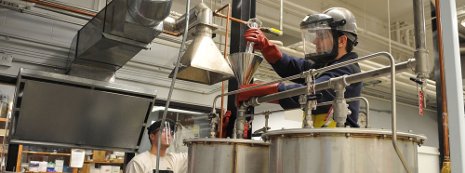Formation of aligned core/sheath microfiber scaffolds with a poly-L-lactic acid (PLLA) sheath and a conductive poly(3,4-ethylenedioxythiophene) (PEDOT) core
Document Type
Article
Publication Date
6-4-2019
Abstract
Electrospun coaxial fibers are used to create core/sheath fiber structures to act as growth-promoting scaffolds for in vitro dorsal root ganglia (DRG) cell cultures. The core was a conducting polymer, poly(3,4-ethylenedioxythiophene):poly(styrene sulfonate) (PEDOT:PSS), and the sheath was poly-L-lactic acid (PLLA), which created coaxial fibers with a conductive core and an insulating sheath. SEM analysis confirmed the conductivity of the core and insulation of the sheath. Several coaxial spinneret designs were tested with the best results obtained by using various annular spinning needle combinations. Using a 22G/16G and 22G/17G combination, fibers with diameters of 6.1 ± 2.4 µm and 3.3 ± 0.9 µm were spun, respectively. The fibers showed a Young’s modulus and hardness of 0.16 ± 0.13 and 0.02 ± 0.01 GPa for the larger diameters, and 0.7 ± 0.4 and 0.03 ± 0.03 GPa for the smaller diameter fibers. In vitro test cultures showed the fibers successfully directed chick DRG axonal outgrowth with low biotoxicity.
Publication Title
Journal of Materials Research
Recommended Citation
Martin, R.,
Wendling, M.,
Mohrenweiser, B.,
Qian, Z.,
Zhao, F.,
&
Mullins, M.
(2019).
Formation of aligned core/sheath microfiber scaffolds with a poly-L-lactic acid (PLLA) sheath and a conductive poly(3,4-ethylenedioxythiophene) (PEDOT) core.
Journal of Materials Research,
34(11), 1931-1943.
http://doi.org/10.1557/jmr.2019.175
Retrieved from: https://digitalcommons.mtu.edu/chemical-fp/16


Publisher's Statement
© Materials Research Society 2019. Publisher’s version of record: https://doi.org/10.1557/jmr.2019.175